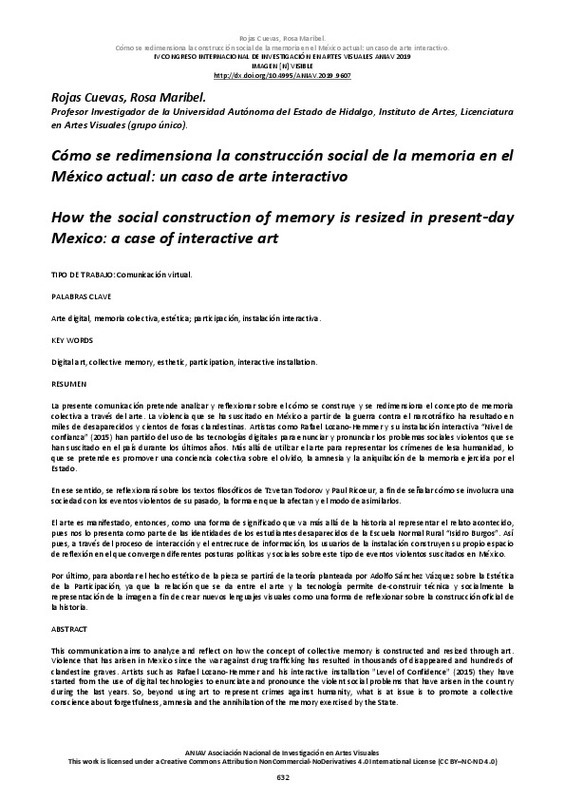|
Resumen:
|
[ES] La presente comunicación pretende analizar y reflexionar sobre el cómo se construye y se redimensiona el concepto de memoria
colectiva a través del arte. La violencia que se ha suscitado en México a partir de la ...[+]
[ES] La presente comunicación pretende analizar y reflexionar sobre el cómo se construye y se redimensiona el concepto de memoria
colectiva a través del arte. La violencia que se ha suscitado en México a partir de la guerra contra el narcotráfico ha resultado en
miles de desaparecidos y cientos de fosas clandestinas. Artistas como Rafael Lozano-Hemmer y su instalación interactiva “Nivel de
confianza” (2015) han partido del uso de las tecnologías digitales para enunciar y pronunciar los problemas sociales violentos que se
han suscitado en el país durante los últimos años. Más allá de utilizar el arte para representar los crímenes de lesa humanidad, lo
que se pretende es promover una conciencia colectiva sobre el olvido, la amnesia y la aniquilación de la memoria ejercida por el
Estado.
En ese sentido, se reflexionará sobre los textos filosóficos de Tzvetan Todorov y Paul Ricoeur, a fin de señalar cómo se involucra una
sociedad con los eventos violentos de su pasado, la forma en que la afectan y el modo de asimilarlos.
El arte es manifestado, entonces, como una forma de significado que va más allá de la historia al representar el relato acontecido,
pues nos lo presenta como parte de las identidades de los estudiantes desaparecidos de la Escuela Normal Rural “Isidro Burgos”. Así
pues, a través del proceso de interacción y el entrecruce de información, los usuarios de la instalación construyen su propio espacio
de reflexión en el que convergen diferentes posturas políticas y sociales sobre este tipo de eventos violentos suscitados en México.
Por último, para abordar el hecho estético de la pieza se partirá de la teoría planteada por Adolfo Sánchez Vázquez sobre la Estética
de la Participación, ya que la relación que se da entre el arte y la tecnología permite de-construir técnica y socialmente la
representación de la imagen a fin de crear nuevos lenguajes visuales como una forma de reflexionar sobre la construcción oficial de
la historia.
[-]
[EN] This communication aims to analyze and reflect on how the concept of collective memory is constructed and resized through art.
Violence that has arisen in Mexico since the war against drug trafficking has resulted ...[+]
[EN] This communication aims to analyze and reflect on how the concept of collective memory is constructed and resized through art.
Violence that has arisen in Mexico since the war against drug trafficking has resulted in thousands of disappeared and hundreds of
clandestine graves. Artists such as Rafael Lozano-Hemmer and his interactive installation "Level of Confidence" (2015) they have
started from the use of digital technologies to enunciate and pronounce the violent social problems that have arisen in the country
during the last years. So, beyond using art to represent crimes against humanity, what is at issue is to promote a collective
conscience about forgetfulness, amnesia and the annihilation of the memory exercised by the State.
In this sense, we will reflect on the philosophical texts of Tzvetan Todorov and Paul Ricoeur; In order to indicate how a society is
involved with the violent events of its past, the way in which they affect it and the way to assimilate them.
Art is then manifested as a form of meaning that goes beyond history, by representing the story that occurred, as it presents us as
part of the identities of the disappeared students of the Rural Normal School "Isidro Burgos". Thus, with the process of interaction
and the intercrossing of information, the users of the facility build their own space of reflection in which different political and social
positions converge on this type of violent events in Mexico.
Finally, to address the aesthetic fact of the piece will be based on the theory put forward by Adolfo Sánchez Vázquez on the
"Aesthetics of Participation"; since the relationship between art and technology allows de-construct technically and socially the
representation of the image, in order to create new visual languages as a way to reflect on the official construction of history.
[-]
|








